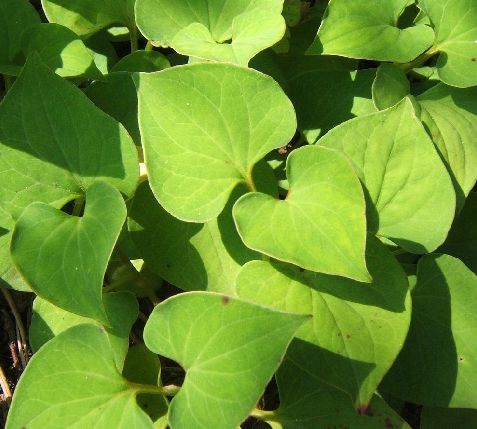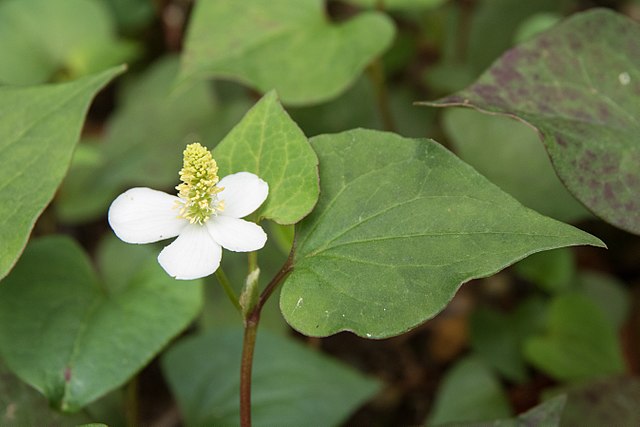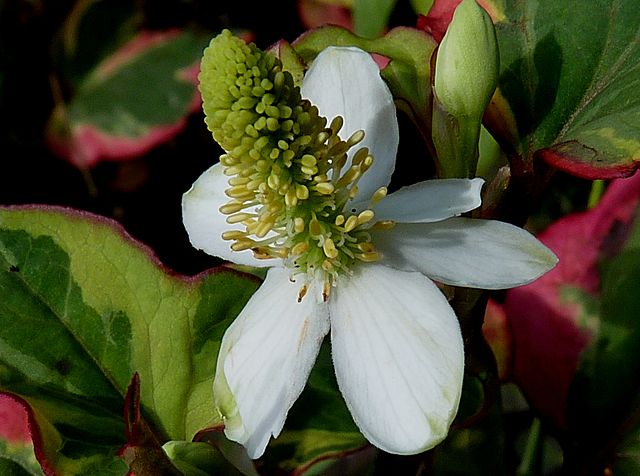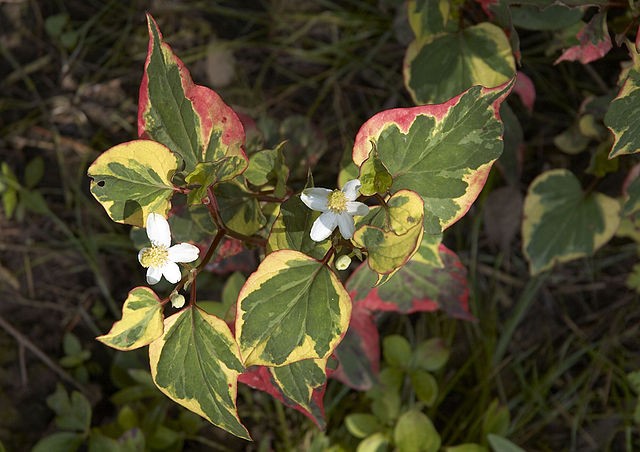Today’s plant is characteristic of the nuances that the Lao language brings in the expression of smells and tastes.
Let’s describe it first: it is an erect herb, up to 30cm high, perennial, on a rhizome deeply buried in the ground. Its leaves are simple, heart-shaped. Its tiny yellow flowers form a terminal spike inflorescence that emerges from a bract of 4 white leaves.
In Thai the plant is called phlou khaao and in Lao khaao thong or more exactly phak Khaao thong because it is a vegetable (phak) whose raw leaves are eaten with lap or grilled meats. However, opinions are very divided on the taste of this plant, some love it and appreciate the special flavor it gives to meat, others, on the contrary, are careful not to add it to their “bite”, considering that it tastes like “poorly washed fish”. The word “khaao” is used for a smell (or taste) of raw meat, blood, raw fish, perspiration of a young child. As for the botanist Vidal, he speaks of “a coppery flavor”, because thong means copper. Let us add that khaao thong also means “verdigris” in Lao. In Cambodia, Marie Martin tells us “the name implies the idea of a disgusting smell and more precisely of raw meat”. In Thailand Annick Lévy notes that khaao also applies to the smell of menstrual blood. These few remarks and what we know elsewhere about the relationship raw/cooked, wild/civilized, suggest that phak khaao thong is classified, in the Lao taxonomy of plants, in the category of “wild”.
In traditional medicine the leaves are used to treat venereal diseases and externally for skin diseases. The whole plant is said to be diuretic and antiseptic for diseases of the genitourinary area.
Finally, it should be added that this plant originating from South East Asia acclimatizes quite well in temperate regions where it is grown as a decorative plant, its leaves can then take on a “variegated” appearance.
La plante d’aujourd’hui est caractéristique des nuances que la langue lao apporte dans l’expression des odeurs et des goûts.
Décrivons-la d’abord: c’est une herbe dressée, jusqu’à 30 cm de haut, pérenne, sur un rhizome profondément enfoncé en terre. Ses feuilles sont simples, en forme de cœur. Ses toutes petites fleurs jaunes constituent une inflorescence terminale en épi qui émerge d’une bractée de 4 feuilles blanches.
En thaï la plante se nomme phlou khaao et en lao khaao thong ou plus exactement phak khaao thong car elle constitue un légume (phak) dont on mange les feuilles crues avec le lap ou les grillades. Cependant les avis sont très partagés sur le goût de cette plante, certains en raffolent et apprécient la saveur spéciale qu’elle donne à la viande, d’autres, au contraire, se gardent bien de l’ajouter à leur « bouchée », considérant qu’elle a un goût de « poisson mal lavé ». Le mot « khaao » s’emploie pour une odeur, (ou un goût), de viande crue, de sang, de poisson cru, de transpiration d’un jeune enfant. Quant au botaniste Vidal il parle « d’une saveur cuivrée », car thong signifie cuivre. Ajoutons que khaao thong signifie aussi en lao « vert-de-gris ». Au Cambodge, nous dit Marie Martin « le nom implique l’idée d’une odeur écœurante et plus précisément de viande crue ». En Thaïlande, Annick Lévy note que khaao s’applique aussi à l’odeur du sang menstruel. Ces quelques remarques et ce que nous savons par ailleurs de la relation cru/cuit, sauvage/civilisé, font penser que phak khaao thong est classé, dans la taxinomie lao des plantes, dans la catégorie du « sauvage ».
Dans la médecine traditionnelle, les feuilles sont employées pour traiter les maladies vénériennes et, en usage externe, pour les maladies de peau. Toute la plante serait diurétique et antiseptique pour les maladies de la zone génito-urinaire.
Ajoutons enfin que cette plante originaire d’Asie du Sud Est s’acclimate assez bien dans les régions tempérées où elle est cultivée comme plante décorative, ses feuilles pouvant alors prendre un aspect « panaché ».




Today’s plant is characteristic of the nuances that the Lao language brings in the expression of smells and tastes.
Let’s describe it first: it is an erect herb, up to 30cm high, perennial, on a rhizome deeply buried in the ground. Its leaves are simple, heart-shaped. Its tiny yellow flowers form a terminal spike inflorescence that emerges from a bract of 4 white leaves.
In Thai the plant is called phlou khaao and in Lao khaao thong or more exactly phak Khaao thong because it is a vegetable (phak) whose raw leaves are eaten with lap or grilled meats. However, opinions are very divided on the taste of this plant, some love it and appreciate the special flavor it gives to meat, others, on the contrary, are careful not to add it to their “bite”, considering that it tastes like “poorly washed fish”. The word “khaao” is used for a smell (or taste) of raw meat, blood, raw fish, perspiration of a young child. As for the botanist Vidal, he speaks of “a coppery flavor”, because thong means copper. Let us add that khaao thong also means “verdigris” in Lao. In Cambodia, Marie Martin tells us “the name implies the idea of a disgusting smell and more precisely of raw meat”. In Thailand Annick Lévy notes that khaao also applies to the smell of menstrual blood. These few remarks and what we know elsewhere about the relationship raw/cooked, wild/civilized, suggest that phak khaao thong is classified, in the Lao taxonomy of plants, in the category of “wild”.
In traditional medicine the leaves are used to treat venereal diseases and externally for skin diseases. The whole plant is said to be diuretic and antiseptic for diseases of the genitourinary area.
Finally, it should be added that this plant originating from South East Asia acclimatizes quite well in temperate regions where it is grown as a decorative plant, its leaves can then take on a “variegated” appearance.
La plante d’aujourd’hui est caractéristique des nuances que la langue lao apporte dans l’expression des odeurs et des goûts.
Décrivons-la d’abord: c’est une herbe dressée, jusqu’à 30 cm de haut, pérenne, sur un rhizome profondément enfoncé en terre. Ses feuilles sont simples, en forme de cœur. Ses toutes petites fleurs jaunes constituent une inflorescence terminale en épi qui émerge d’une bractée de 4 feuilles blanches.
En thaï la plante se nomme phlou khaao et en lao khaao thong ou plus exactement phak khaao thong car elle constitue un légume (phak) dont on mange les feuilles crues avec le lap ou les grillades. Cependant les avis sont très partagés sur le goût de cette plante, certains en raffolent et apprécient la saveur spéciale qu’elle donne à la viande, d’autres, au contraire, se gardent bien de l’ajouter à leur « bouchée », considérant qu’elle a un goût de « poisson mal lavé ». Le mot « khaao » s’emploie pour une odeur, (ou un goût), de viande crue, de sang, de poisson cru, de transpiration d’un jeune enfant. Quant au botaniste Vidal il parle « d’une saveur cuivrée », car thong signifie cuivre. Ajoutons que khaao thong signifie aussi en lao « vert-de-gris ». Au Cambodge, nous dit Marie Martin « le nom implique l’idée d’une odeur écœurante et plus précisément de viande crue ». En Thaïlande, Annick Lévy note que khaao s’applique aussi à l’odeur du sang menstruel. Ces quelques remarques et ce que nous savons par ailleurs de la relation cru/cuit, sauvage/civilisé, font penser que phak khaao thong est classé, dans la taxinomie lao des plantes, dans la catégorie du « sauvage ».
Dans la médecine traditionnelle, les feuilles sont employées pour traiter les maladies vénériennes et, en usage externe, pour les maladies de peau. Toute la plante serait diurétique et antiseptique pour les maladies de la zone génito-urinaire.
Ajoutons enfin que cette plante originaire d’Asie du Sud Est s’acclimate assez bien dans les régions tempérées où elle est cultivée comme plante décorative, ses feuilles pouvant alors prendre un aspect « panaché ».








Today’s plant is characteristic of the nuances that the Lao language brings in the expression of smells and tastes.
Let’s describe it first: it is an erect herb, up to 30cm high, perennial, on a rhizome deeply buried in the ground. Its leaves are simple, heart-shaped. Its tiny yellow flowers form a terminal spike inflorescence that emerges from a bract of 4 white leaves.
In Thai the plant is called phlou khaao and in Lao khaao thong or more exactly phak Khaao thong because it is a vegetable (phak) whose raw leaves are eaten with lap or grilled meats. However, opinions are very divided on the taste of this plant, some love it and appreciate the special flavor it gives to meat, others, on the contrary, are careful not to add it to their “bite”, considering that it tastes like “poorly washed fish”. The word “khaao” is used for a smell (or taste) of raw meat, blood, raw fish, perspiration of a young child. As for the botanist Vidal, he speaks of “a coppery flavor”, because thong means copper. Let us add that khaao thong also means “verdigris” in Lao. In Cambodia, Marie Martin tells us “the name implies the idea of a disgusting smell and more precisely of raw meat”. In Thailand Annick Lévy notes that khaao also applies to the smell of menstrual blood. These few remarks and what we know elsewhere about the relationship raw/cooked, wild/civilized, suggest that phak khaao thong is classified, in the Lao taxonomy of plants, in the category of “wild”.
In traditional medicine the leaves are used to treat venereal diseases and externally for skin diseases. The whole plant is said to be diuretic and antiseptic for diseases of the genitourinary area.
Finally, it should be added that this plant originating from South East Asia acclimatizes quite well in temperate regions where it is grown as a decorative plant, its leaves can then take on a “variegated” appearance.
La plante d’aujourd’hui est caractéristique des nuances que la langue lao apporte dans l’expression des odeurs et des goûts.
Décrivons-la d’abord: c’est une herbe dressée, jusqu’à 30 cm de haut, pérenne, sur un rhizome profondément enfoncé en terre. Ses feuilles sont simples, en forme de cœur. Ses toutes petites fleurs jaunes constituent une inflorescence terminale en épi qui émerge d’une bractée de 4 feuilles blanches.
En thaï la plante se nomme phlou khaao et en lao khaao thong ou plus exactement phak khaao thong car elle constitue un légume (phak) dont on mange les feuilles crues avec le lap ou les grillades. Cependant les avis sont très partagés sur le goût de cette plante, certains en raffolent et apprécient la saveur spéciale qu’elle donne à la viande, d’autres, au contraire, se gardent bien de l’ajouter à leur « bouchée », considérant qu’elle a un goût de « poisson mal lavé ». Le mot « khaao » s’emploie pour une odeur, (ou un goût), de viande crue, de sang, de poisson cru, de transpiration d’un jeune enfant. Quant au botaniste Vidal il parle « d’une saveur cuivrée », car thong signifie cuivre. Ajoutons que khaao thong signifie aussi en lao « vert-de-gris ». Au Cambodge, nous dit Marie Martin « le nom implique l’idée d’une odeur écœurante et plus précisément de viande crue ». En Thaïlande, Annick Lévy note que khaao s’applique aussi à l’odeur du sang menstruel. Ces quelques remarques et ce que nous savons par ailleurs de la relation cru/cuit, sauvage/civilisé, font penser que phak khaao thong est classé, dans la taxinomie lao des plantes, dans la catégorie du « sauvage ».
Dans la médecine traditionnelle, les feuilles sont employées pour traiter les maladies vénériennes et, en usage externe, pour les maladies de peau. Toute la plante serait diurétique et antiseptique pour les maladies de la zone génito-urinaire.
Ajoutons enfin que cette plante originaire d’Asie du Sud Est s’acclimate assez bien dans les régions tempérées où elle est cultivée comme plante décorative, ses feuilles pouvant alors prendre un aspect « panaché ».


